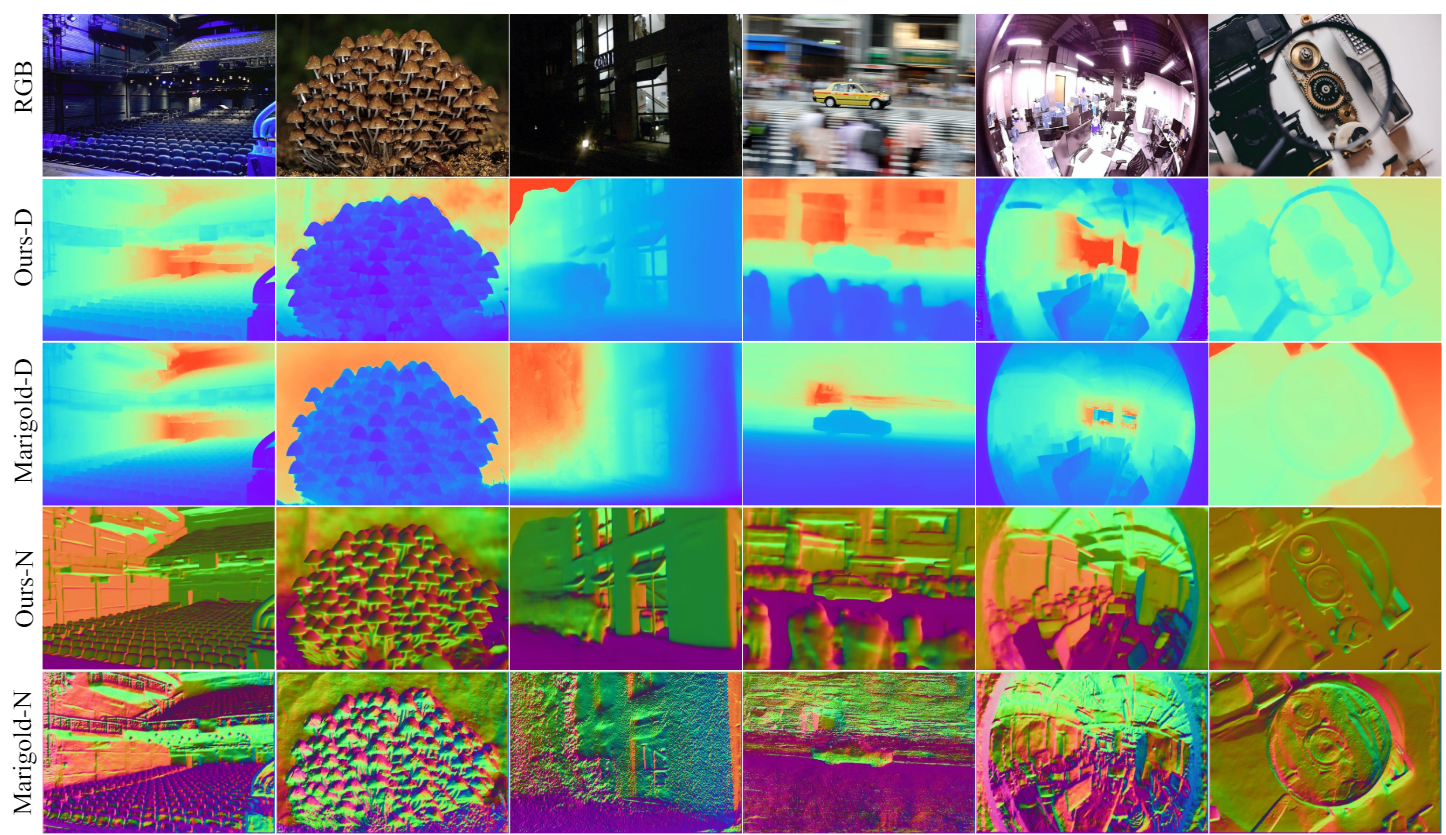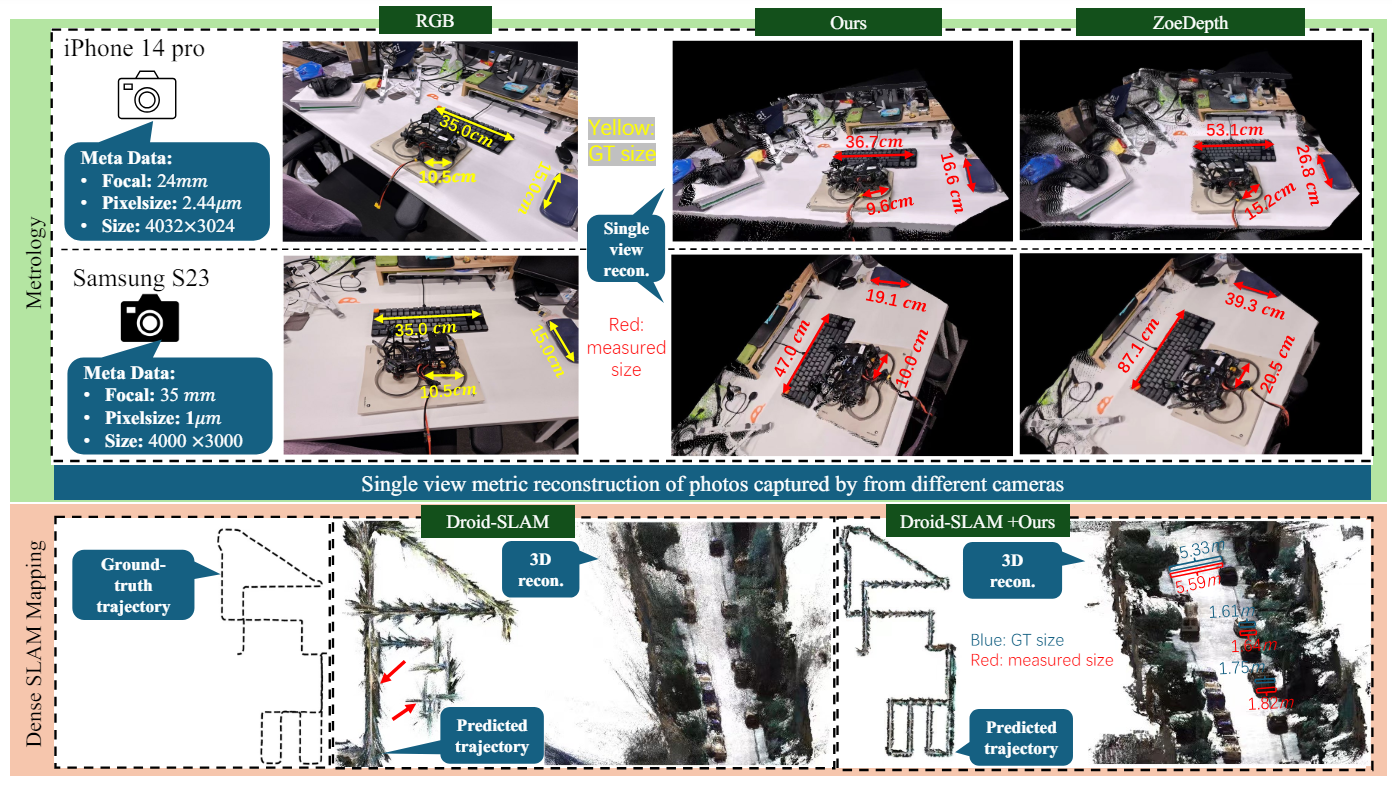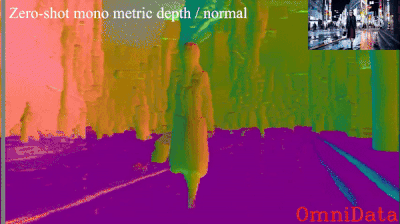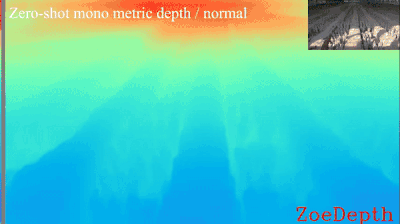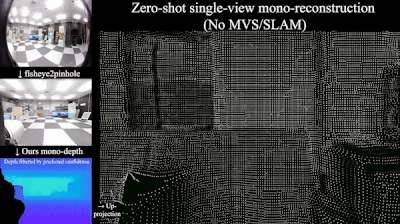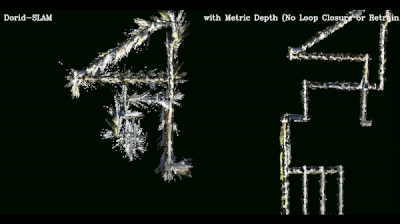Official PyTorch implementation of Metric3Dv1 and Metric3Dv2:
[1] Metric3D: Towards Zero-shot Metric 3D Prediction from A Single Image
🏆 Champion in CVPR2023 Monocular Depth Estimation Challenge
[2024/4/25]Weights for ViT-giant2 model released![2024/4/11]Training codes are released![2024/3/18]HuggingFace 🤗 GPU version updated![2024/3/18]Project page released![2024/3/18]Metric3D V2 models released, supporting metric depth and surface normal now![2023/8/10]Inference codes, pre-trained weights, and demo released.[2023/7]Metric3D accepted by ICCV 2023![2023/4]The Champion of 2nd Monocular Depth Estimation Challenge in CVPR 2023
Metric3D is a strong and robust geometry foundation model for high-quality and zero-shot metric depth and surface normal estimation from a single image. It excels at solving in-the-wild scene reconstruction. It can directly help you measure the size of structures from a single image. Now it achieves SOTA performance on over 10 depth and normal benchmarks.
Our models rank 1st on the routing KITTI and NYU benchmarks.
| Backbone | KITTI δ1 ↑ | KITTI δ2 ↑ | KITTI AbsRel ↓ | KITTI RMSE ↓ | KITTI RMS_log ↓ | NYU δ1 ↑ | NYU δ2 ↑ | NYU AbsRel ↓ | NYU RMSE ↓ | NYU log10 ↓ | |
|---|---|---|---|---|---|---|---|---|---|---|---|
| ZoeDepth | ViT-Large | 0.971 | 0.995 | 0.053 | 2.281 | 0.082 | 0.953 | 0.995 | 0.077 | 0.277 | 0.033 |
| ZeroDepth | ResNet-18 | 0.968 | 0.996 | 0.057 | 2.087 | 0.083 | 0.954 | 0.995 | 0.074 | 0.269 | 0.103 |
| IEBins | SwinT-Large | 0.978 | 0.998 | 0.050 | 2.011 | 0.075 | 0.936 | 0.992 | 0.087 | 0.314 | 0.031 |
| DepthAnything | ViT-Large | 0.982 | 0.998 | 0.046 | 1.985 | 0.069 | 0.984 | 0.998 | 0.056 | 0.206 | 0.024 |
| Ours | ViT-Large | 0.985 | 0.998 | 0.999 | 1.985 | 0.064 | 0.989 | 0.998 | 0.047 | 0.183 | 0.020 |
| Ours | ViT-giant2 | 0.989 | 0.998 | 1.000 | 1.766 | 0.060 | 0.987 | 0.997 | 0.045 | 0.187 | 0.015 |
Even compared to recent affine-invariant depth methods (Marigold and Depth Anything), our metric-depth (and normal) models still show superior performance.
| #Data for Pretrain and Train | KITTI Absrel ↓ | KITTI δ1 ↑ | NYUv2 AbsRel ↓ | NYUv2 δ1 ↑ | DIODE-Full AbsRel ↓ | DIODE-Full δ1 ↑ | Eth3d AbsRel ↓ | Eth3d δ1 ↑ | |
|---|---|---|---|---|---|---|---|---|---|
| OmniData (v2, ViT-L) | 1.3M + 12.2M | 0.069 | 0.948 | 0.074 | 0.945 | 0.149 | 0.835 | 0.166 | 0.778 |
| MariGold (LDMv2) | 5B + 74K | 0.099 | 0.916 | 0.055 | 0.961 | 0.308 | 0.773 | 0.127 | 0.960 |
| DepthAnything (ViT-L) | 142M + 63M | 0.076 | 0.947 | 0.043 | 0.981 | 0.277 | 0.759 | 0.065 | 0.882 |
| Ours (ViT-L) | 142M + 16M | 0.042 | 0.979 | 0.042 | 0.980 | 0.141 | 0.882 | 0.042 | 0.987 |
| Ours (ViT-g) | 142M + 16M | 0.043 | 0.982 | 0.043 | 0.981 | 0.136 | 0.895 | 0.042 | 0.983 |
Our models also show powerful performance on normal benchmarks.
| NYU 11.25° ↑ | NYU Mean ↓ | NYU RMS ↓ | ScanNet 11.25° ↑ | ScanNet Mean ↓ | ScanNet RMS ↓ | iBims 11.25° ↑ | iBims Mean ↓ | iBims RMS ↓ | |
|---|---|---|---|---|---|---|---|---|---|
| EESNU | 0.597 | 16.0 | 24.7 | 0.711 | 11.8 | 20.3 | 0.585 | 20.0 | - |
| IronDepth | - | - | - | - | - | - | 0.431 | 25.3 | 37.4 |
| PolyMax | 0.656 | 13.1 | 20.4 | - | - | - | - | - | - |
| Ours (ViT-L) | 0.688 | 12.0 | 19.2 | 0.760 | 9.9 | 16.4 | 0.694 | 19.4 | 34.9 |
| Ours (ViT-g) | 0.662 | 13.2 | 20.2 | 0.778 | 9.2 | 15.3 | 0.697 | 19.6 | 35.2 |
For the ViT models, use the following environment:
pip install -r requirements_v2.txtFor ConvNeXt-L, it is
pip install -r requirements_v1.txtWith off-the-shelf depth datasets, we need to generate json annotaions in compatible with this dataset, which is organized by:
dict(
'files':list(
dict(
'rgb': 'data/kitti_demo/rgb/xxx.png',
'depth': 'data/kitti_demo/depth/xxx.png',
'depth_scale': 1000.0 # the depth scale of gt depth img.
'cam_in': [fx, fy, cx, cy],
),
dict(
...
),
...
)
)
To generate such annotations, please refer to the "Inference" section.
In mono/configs we provide different config setups.
Intrinsics of the canonical camera is set bellow:
canonical_space = dict(
img_size=(512, 960),
focal_length=1000.0,
),
where cx and cy is set to be half of the image size.
Inference settings are defined as
depth_range=(0, 1),
depth_normalize=(0.3, 150),
crop_size = (512, 1088),
where the images will be first resized as the crop_size and then fed into the model.
Please refer to training/README.md.
Now you can use Metric3D via Pytorch Hub with just few lines of code:
import torch
model = torch.hub.load('yvanyin/metric3d', 'metric3d_vit_small', pretrain=True)
pred_depth, confidence, output_dict = model.inference({'input': rgb})Supported models: metric3d_convnext_large, metric3d_vit_small, metric3d_vit_large, metric3d_vit_giant2.
We also provided a minimal working example in hubconf.py, which hopefully makes everything clearer.
| Encoder | Decoder | Link | |
|---|---|---|---|
| v1-T | ConvNeXt-Tiny | Hourglass-Decoder | Coming soon |
| v1-L | ConvNeXt-Large | Hourglass-Decoder | Download |
| v2-S | DINO2reg-ViT-Small | RAFT-4iter | Download |
| v2-L | DINO2reg-ViT-Large | RAFT-8iter | Download |
| v2-g | DINO2reg-ViT-giant2 | RAFT-8iter | Download 🤗 |
- put the trained ckpt file
model.pthinweight/. - generate data annotation by following the code
data/gene_annos_kitti_demo.py, which includes 'rgb', (optional) 'intrinsic', (optional) 'depth', (optional) 'depth_scale'. - change the 'test_data_path' in
test_*.shto the*.jsonpath. - run
source test_kitti.shorsource test_nyu.sh.
- put the trained ckpt file
model.pthinweight/. - change the 'test_data_path' in
test.shto the image folder path. - run
source test_vit.shfor transformers andsource test.shfor convnets. As no intrinsics are provided, we provided by default 9 settings of focal length.
If you are interested in combining metric3D and monocular visual slam system to achieve the metric slam, you can refer to this repo.
Because the focal length is not properly set! Please find a proper focal length by modifying codes here yourself.
Because the images are too large! Use smaller ones instead.
First be sure all black padding regions at image boundaries are cropped out. Then please try again. Besides, metric 3D is not almighty. Some objects (chandeliers, drones...) / camera views (aerial view, bev...) do not occur frequently in the training datasets. We will going deeper into this and release more powerful solutions.
@article{hu2024metric3dv2,
title={Metric3D v2: A Versatile Monocular Geometric Foundation Model for Zero-shot Metric Depth and Surface Normal Estimation},
author={Hu, Mu and Yin, Wei and Zhang, Chi and Cai, Zhipeng and Long, Xiaoxiao and Chen, Hao and Wang, Kaixuan and Yu, Gang and Shen, Chunhua and Shen, Shaojie},
journal={arXiv preprint arXiv:2404.15506},
year={2024}
}
@article{yin2023metric,
title={Metric3D: Towards Zero-shot Metric 3D Prediction from A Single Image},
author={Wei Yin, Chi Zhang, Hao Chen, Zhipeng Cai, Gang Yu, Kaixuan Wang, Xiaozhi Chen, Chunhua Shen},
booktitle={ICCV},
year={2023}
}
The Metric 3D code is under a 2-clause BSD License for non-commercial usage. For further questions, contact Dr. Wei Yin [yvanwy@outlook.com] and Mr. Mu Hu [mhuam@connect.ust.hk].









